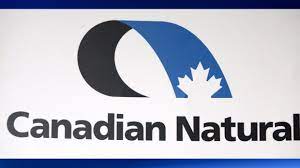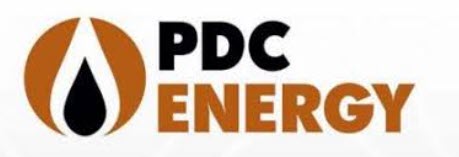
DENVER, May 05, 2021 (GLOBE NEWSWIRE) — PDC Energy, Inc. (“PDC” or the “Company”) (Nasdaq:PDCE) today announced its 2021 first quarter financial and operating results.
2021 First Quarter Highlights:
- Net cash from operating activities of approximately $355 million, adjusted cash flows from operations, a non-U.S. GAAP metric defined below, of approximately $300 million and oil and gas capital investments of approximately $125 million.
- Approximately $175 million of adjusted free cash flow (“FCF”), a non-U.S. GAAP metric defined below.
- Reduced total net debt by approximately $230 million, resulting in an undrawn revolving credit facility, cash balance of approximately $60 million and total liquidity of $1.7 billion as of March 31, 2021.
- Returned $22 million of capital to shareholders through the repurchase of approximately 600,000 shares of common stock outstanding.
- Total production of 15.7 million barrels of oil equivalent (“MMBoe”) or approximately 175,000 Boe per day and oil production of 4.9 million barrels (“MMBbls”) or nearly 54,000 Bbls per day.
CEO Commentary
President and Chief Executive Officer Bart Brookman commented, “Once again, our results clearly reflect the company’s priorities: sustainable free cash flow, debt reduction and shareholder returns. Since closing the SRC merger in early 2020, PDC has generated nearly $600 million of free cash flow while reducing debt by approximately $500 million. The Company’s financial strength, combined with its focus on shareholder returns and operational excellence, make PDC’s story particularly compelling.”
Operations Update
In the first quarter of 2021, PDC invested approximately $125 million while delivering total production of 15.7 million Boe, or 175,000 Boe per day, and oil production of 4.9 million barrels, or 54,000 barrels per day. Total production and oil production represent sequential decreases of three percent and 11 percent on a daily basis, respectively, compared to the fourth quarter of 2020, and reflect the negative impact of adverse winter weather conditions in each February and March. The Company estimates a weather-related impact to total production and oil production of approximately 500,000 Boe and 200,000 barrels in the first quarter. In spite of the negative impact to volumes, the Company generated approximately $175 million of FCF in the quarter and paid down approximately $230 million of net debt while returning $22 million of capital to shareholders through the repurchase of approximately 600,000 shares of common stock outstanding.
In Wattenberg, the Company invested approximately $95 million to operate one drilling rig and one completion crew in the first quarter, resulting in 20 spuds and 34 turn-in-lines (“TILs”). Total production was 13.9 million Boe, or approximately 155,000 Boe per day, while oil production was approximately 4.2 million Bbls, or approximately 46,500 Bbls per day.
PDC exited the first quarter with approximately 200 drilled, uncompleted wells (“DUCs”) and approximately 290 approved permits in-hand. The Company continues to successfully progress towards the submittal of two Oil and Gas Development Plans (“OGDP”) and a Comprehensive Area Plan (“CAP”) aimed at securing future drilling permits. The Spinney OGDP, consisting of eight wells is on track to be applied for in the second quarter, while the Kenosha OGDP, consisting of approximately 70 wells, is expected to be applied for late in the second quarter or early third quarter. Finally, the Company is in the process of completing its cumulative impact analysis and expects to submit its application for the Guanella CAP, consisting of approximately 450 wells, by the end of 2021. Additional information can be found in the Company’s presentation, available at www.pdce.com.
In the Delaware Basin, PDC invested approximately $30 million to operate one drilling rig and a part-time completion crew, resulting in four spuds and zero TILs. Total production was 1.8 million Boe, or approximately 20,500 Boe per day, while oil production was approximately 700,000 Bbls, or approximately 7,500 Boe per day. Year-to-date, the Company is averaging approximately 17 days from spud to rig-release, representing a 20 percent improvement compared to 2021 guidance assumptions.
2021 Capital Investment and Financial Guidance
PDC’s 2021 capital investment guidance of $500 million to $600 million remains unchanged as service cost inflation related to higher than anticipated crude oil prices has been relatively minor thus far. PDC is confident it can complete its 2021 operating program within the stated guidance range and is committed to demonstrating capital discipline and adjusting its operating cadence to stay within the range should service cost inflation and/or increases to expected non-operated activity warrant.
Further, in accordance with year-to-date commodity prices and expected pricing for the remainder of the year, the Company has adjusted its internal budget-related pricing to $55 per Bbl WTI, $2.50 per Mcf NYMEX natural gas and $15 NGL realizations. Under these assumptions, PDC now expects to generate more than $600 million of FCF and exit the year with a leverage ratio of approximately 1.0x.
Keeping percent realizations constant, the Company projects commodity price fluctuations to change its estimated adjusted cash flows from operations as follows: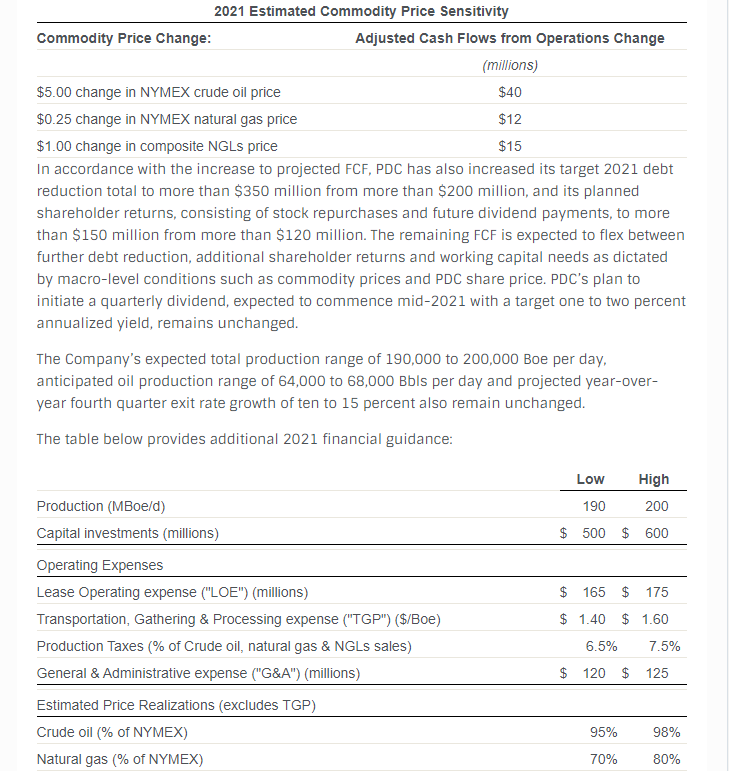
Quarterly Commentary
PDC expects to invest nearly $200 million in the second quarter of 2021 to operate a full-time drilling rig and completion crew in each basin, while delivering total production and oil production equating to five to ten percent sequential growth compared to the first quarter on a daily basis. Under its updated commodity price assumptions, the Company projects more than $75 million of FCF.
Multi-Year Outlook
The Company’s planned capital investments and operating activity through 2023 remains unchanged. Assuming $55 per Bbl WTI, $2.50 per Mcf NYMEX natural gas and $15 NGL realizations, PDC now expects to generate more than $600 million of FCF in each of the next three years. The projected cumulative FCF of $1.8 to $2.0 billion equates to more than 50 percent of PDC’s current market cap and more than 40 percent of the current enterprise value.
Under the same price assumptions, PDC’s reinvestment rate equates to less than 50 percent of its adjusted cash flows from operations in the development of crude oil and natural gas. Further, the Company plans to pay down at least $850 million of total debt and return more than $650 million of capital to shareholders through its stock repurchase program and future dividend program.
The targets represent increases from prior projections of $600 million of debt reduction and $500 million of shareholder returns. Similar to 2021 expectations, remaining cash flows are expected to flex between further debt reduction, additional shareholder returns and working capital needs as dictated by macro-level conditions such as commodity prices and PDC share price.
Hedging Overview
In 2021, the Company has approximately 14.0 MMBbls of oil hedges at a weighted-average floor price of approximately $45 per Bbl. Excluding approximately 3.3 MMBbls of settled hedges in the first quarter, the Company’s remaining swaps and costless collars represent approximately 60 percent of its projected oil volumes through year-end. Approximately 55 percent of the Company’s estimated gas production between the second and fourth quarters are protected at approximately $2.45 per MMBtu. PDC has completed its base layer hedging for 2022 and begun layering in preliminary 2023 positions.
The Company’s hedging strategy is predicated on systematically layering in oil and natural gas swaps and costless collars, as well as evaluating basis swaps and physical hedges when appropriate.
Oil and Gas Production, Sales and Operating Cost Data
Crude oil, natural gas and NGLs sales, excluding net settlements on derivatives were $468 million, a 46 percent increase over 2020 levels of $320 million. The increase in sales between periods was due to a 56 percent increase in weighted-average realized sales price to $29.74 from $19.02 offsetting an 18 percent decrease in oil production and seven percent decrease in total production. The increase in sales price per Boe was driven by 33 percent, 174 percent and 172 percent increases in weighted-average realized oil, natural gas and NGL prices, respectively; while the decreases in oil production and total production between periods was due to reduced drilling and completion activity in the second half of 2020. The combined revenue from crude oil, natural gas and NGLs sales and net settlements received on commodity derivative instruments was approximately $437 million in 2021 compared to approximately $365 million in 2020.
The following table provides weighted-average sales price, by area, for the three months ended March 31, 2021 and 2020, excluding net settlements on derivatives and TGP:
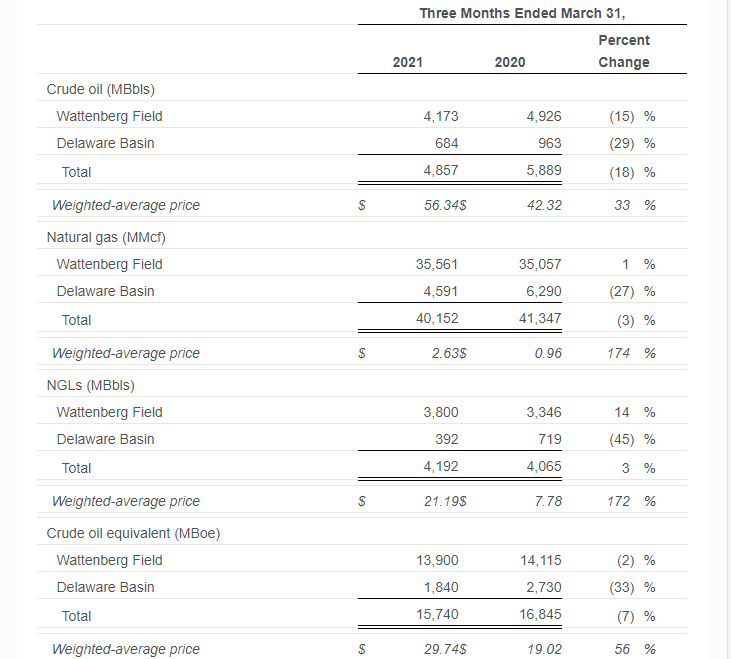
Production costs for the first quarter of 2021, which include LOE, production taxes and TGP, were $93 million, or $5.91 per Boe, compared to $82 million, or $4.84 per Boe, in 2020. LOE per Boe improved ten percent compared to the first quarter of 2020 primarily due to efficiency gains realized in conjunction with the Company’s acquisition of SRC Energy in the first quarter of 2020. TGP worsened 73 percent per Boe over the comparable period due to certain contracts allocating deducts as TGP, resulting in improved gross realizations and project economics. Production taxes for the first quarter of 2021 were $29.5 million, or $1.87 per Boe, compared to $18.5 million, or $1.10 per Boe in the comparable 2020 period. The 70 percent increase per Boe between periods is due to the aforementioned increase in sales.
The following table provides the components of production costs for the three months ended March 31, 2021 and 2020: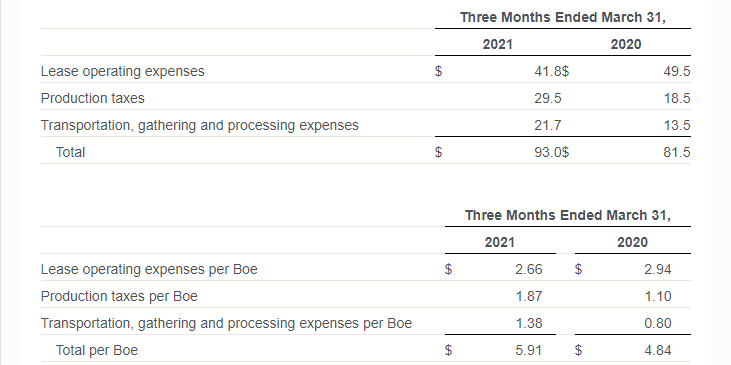
Financial Results
Net loss for the first quarter of 2021 was approximately $9 million, or $0.09 per diluted share, compared to a net loss of $465 million, or $4.94 per diluted share in 2020. The year-over-year change was primarily due to a 2020 impairment of approximately $880 million and the change in value of unsettled derivatives. Adjusted net income, a non-U.S. GAAP financial measure defined below, was $142 million in 2021 compared to an adjusted net loss of $760 million in 2020. The difference between adjusted net income (loss) between periods is primarily attributable to the aforementioned impairment.
Net cash from operating activities for the first quarter of 2021 was approximately $353 million compared to $266 million in the comparable 2020 period. Adjusted cash flows from operations, a non-U.S. GAAP metric defined below, was approximately $300 million in the first quarter of 2021 compared to approximately $210 million in the comparable 2020 period. The year-over-year increase in each metric was primarily due to the increase in sales offset by the increase in costs and change in derivative settlements.
G&A, which includes cash and non-cash expense, was $33 million, or $2.08 per Boe in the first quarter of 2021 compared to $62 million, or $3.69 per Boe, in the first quarter of 2020. First quarter 2020 G&A included approximately $20 million, or $1.19 per Boe, of deal costs associated with the SRC Energy merger. Excluding deal-related costs from 2020 G&A would result in G&A per Boe of approximately $2.50, approximately 17 percent higher than 2021 G&A per Boe.
Reconciliation of Non-U.S. GAAP Financial Measures
We use “adjusted cash flows from operations,” “adjusted free cash flow (deficit),” “adjusted net income (loss)” and “adjusted EBITDAX,” non-U.S. GAAP financial measures, for internal management reporting, when evaluating period-to-period changes and, in some cases, in providing public guidance on possible future results. In addition, we believe these are measures of our fundamental business and can be useful to us, investors, lenders and other parties in the evaluation of our performance relative to our peers and in assessing acquisition opportunities and capital expenditure projects. These supplemental measures are not measures of financial performance under U.S. GAAP and should be considered in addition to, not as a substitute for, net income (loss) or cash flows from operations, investing or financing activities and should not be viewed as liquidity measures or indicators of cash flows reported in accordance with U.S. GAAP. The non-U.S. GAAP financial measures that we use may not be comparable to similarly titled measures reported by other companies. In the future, we may disclose different non-U.S. GAAP financial measures in order to help us and our investors more meaningfully evaluate and compare our future results of operations to our previously reported results of operations. We strongly encourage investors to review our financial statements and publicly filed reports in their entirety and to not rely on any single financial measure.
Adjusted cash flows from operations and adjusted free cash flow (deficit). We believe adjusted cash flows from operations can provide additional transparency into the drivers of trends in our operating cash flows, such as production, realized sales prices and operating costs, as it disregards the timing of settlement of operating assets and liabilities. We believe adjusted free cash flow (deficit) provides additional information that may be useful in an investor analysis of our ability to generate cash from operating activities from our existing oil and gas asset base to fund exploration and development activities and to return capital to stockholders in the period in which the related transactions occurred. We exclude from this measure cash receipts and expenditures related to acquisitions and divestitures of oil and gas properties and capital expenditures for other properties and equipment, which are not reflective of the cash generated or used by ongoing activities on our existing producing properties and, in the case of acquisitions and divestitures, may be evaluated separately in terms of their impact on our performance and liquidity. Adjusted free cash flow is a supplemental measure of liquidity and should not be viewed as a substitute for cash flows from operations because it excludes certain required cash expenditures. For example, we may have mandatory debt service requirements or other non-discretionary expenditures which are not deducted from the adjusted free cash flow measure.
We are unable to present a reconciliation of forward-looking adjusted cash flow because components of the calculation, including fluctuations in working capital accounts, are inherently unpredictable. Moreover, estimating the most directly comparable GAAP measure with the required precision necessary to provide a meaningful reconciliation is extremely difficult and could not be accomplished without unreasonable effort. We believe that forward-looking estimates of adjusted cash flow are important to investors because they assist in the analysis of our ability to generate cash from our operations.
Adjusted net income (loss) . We believe that adjusted net income (loss) provides additional transparency into operating trends, such as production, realized sales prices, operating costs and net settlements on commodity derivative contracts, because it disregards changes in our net income (loss) from mark-to-market adjustments resulting from net changes in the fair value of our unsettled commodity derivative contracts, and these changes are not directly reflective of our operating performance.
Adjusted EBITDAX. We believe that adjusted EBITDAX provides additional transparency into operating trends because it reflects the financial performance of our assets without regard to financing methods, capital structure, accounting methods or historical cost basis. In addition, because adjusted EBITDAX excludes certain non-cash expenses, we believe it is not a measure of income, but rather a measure of our liquidity and ability to generate sufficient cash for exploration, development, and acquisitions and to service our debt obligations.
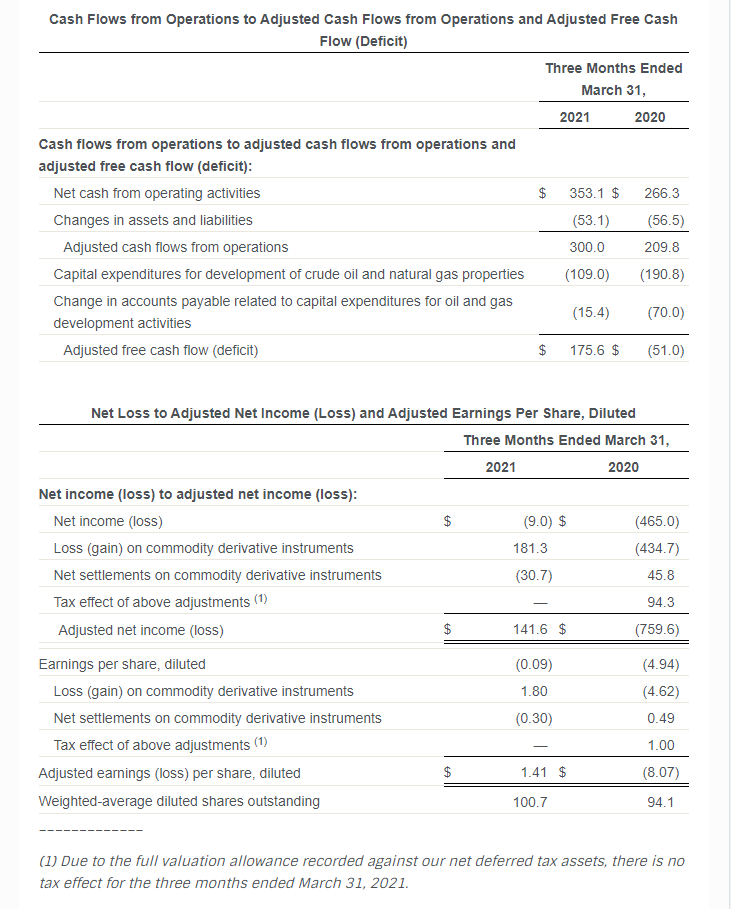

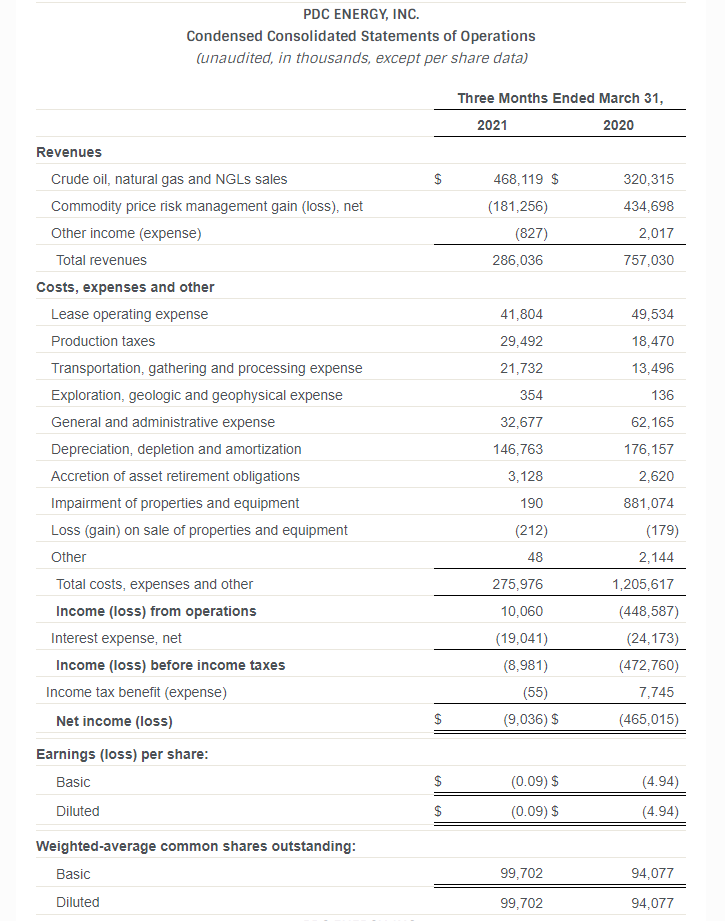
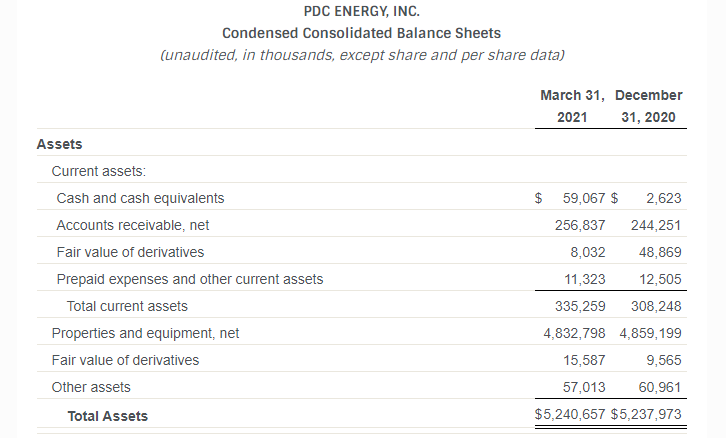
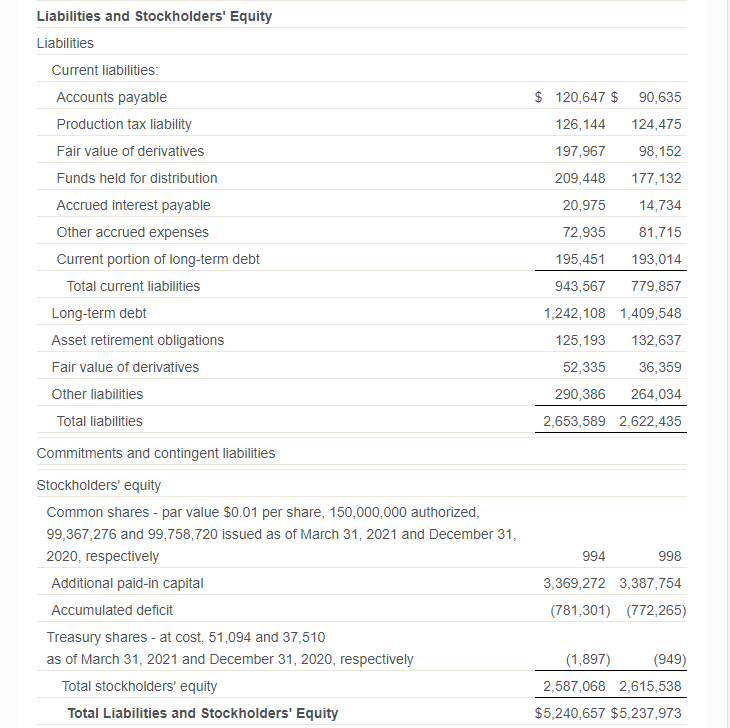
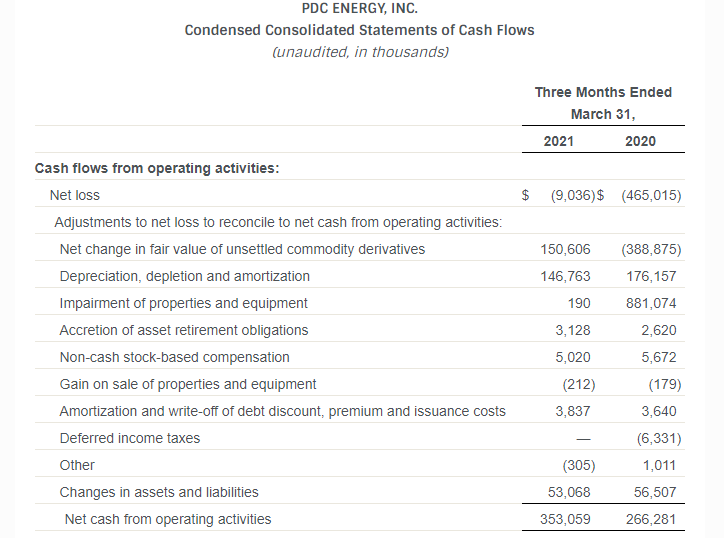
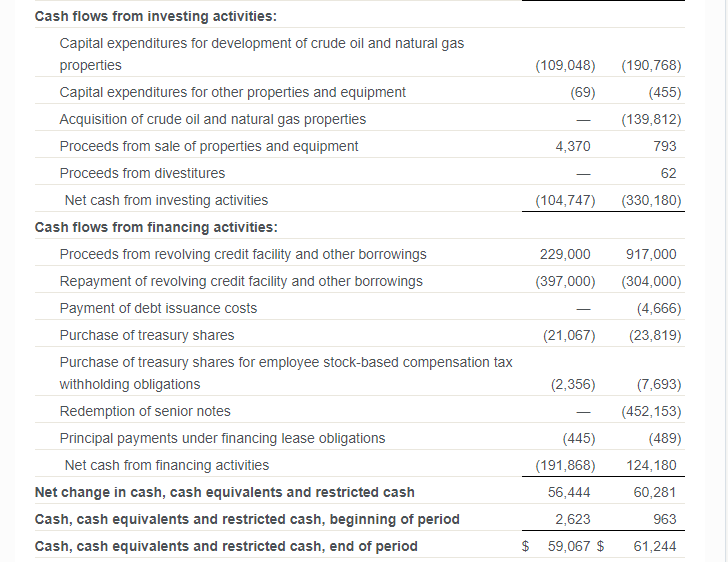
2021 First Quarter Teleconference and Webcast
The Company invites you to join Bart Brookman, President and Chief Executive Officer; Scott Meyers, Chief Financial Officer; Lance Lauck, Executive Vice President Corporate Development and Strategy; and David Lillo, Senior Vice President Operations for a conference call on Thursday, May 6, 2021, to discuss its 2021 first quarter results. The related slide presentation will be available on PDC’s website at www.pdce.com.
Conference Call and Webcast:
Date/Time: Thursday, May 6, 2021 at 11:00 a.m. ET
Domestic (toll free): 877-312-5520
International: 1-253-237-1142
Conference ID: 1178458
Webcast: available at www.pdce.com
Replay Information:
Domestic (toll free): 855-859-2056
International: 1-404-537-3406
Conference ID: 7464278
Webcast Replay: available for six months at www.pdce.com
Upcoming Investor Presentations
PDC is scheduled to participate in the Citi 2021 Global Energy & Utilities Virtual Conference on Tuesday, May 11, 2021; the 2021 Virtual Wells Fargo Energy Conference on Thursday, June 2, 2021; the BofA Securities 2021 Virtual Energy Credit Conference on Thursday, June 10; and the JP Morgan Energy, Power and Renewable Conference on Tuesday, June 22, 2021. Updated presentations will be posted to the Company’s website, www.pdce.com , prior to the start of each conference.
About PDC Energy, Inc.
PDC Energy, Inc. is a domestic independent exploration and production company that acquires, explores and develops properties for the production of crude oil, natural gas and NGLs, with operations in the Wattenberg Field in Colorado and Delaware Basin in west Texas. Its operations in the Wattenberg Field are focused in the horizontal Niobrara and Codell plays and our Delaware Basin operations are primarily focused in the horizontal Wolfcamp zones.
SPECIAL NOTE REGARDING FORWARD-LOOKING STATEMENTS
This press release contains forward-looking statements within the meaning of Section 27A of the Securities Act of 1933 (“Securities Act”), Section 21E of the Securities Exchange Act of 1934 (“Exchange Act”) and the United States (“U.S.”) Private Securities Litigation Reform Act of 1995 regarding our business, financial condition, results of operations and prospects. All statements other than statements of historical fact included in and incorporated by reference into this release are “forward-looking statements.” Words such as expect, anticipate, intend, plan, believe, seek, estimate, schedule and similar expressions or variations of such words are intended to identify forward-looking statements herein. Forward-looking statements include, among other things, statements regarding future: production, costs and cash flows; impacts of Colorado political matters, including recent rulemaking initiatives; our ability to continue to obtain permits; drilling locations, zones and growth opportunities; commodity prices and differentials; capital expenditures and projects, including the number of rigs employed; cash flows from operations relative to future capital investments; financial ratios and compliance with covenants in our revolving credit facility and other debt instruments; impacts of certain accounting and tax changes; ability to meet our volume commitments to midstream providers and timing and adequacy of midstream infrastructure; the potential return of capital to shareholders through buybacks of shares and/or payments of dividends; ongoing compliance with our consent decree; risk of our counterparties non-performance on derivative instruments; and our ability to repay our 1.125% convertible notes due 2021 (the “2021 Convertible Notes”) and fund planned activities.
The above statements are not the exclusive means of identifying forward-looking statements herein. Although forward-looking statements contained in this press release reflect our good faith judgment, such statements can only be based on facts and factors currently known to us. Forward-looking statements are always subject to risks and uncertainties, and become subject to greater levels of risk and uncertainty as they address matters further into the future. Throughout this press release or accompanying materials, we may use the term “projection” or similar terms or expressions, or indicate that we have “modeled” certain future scenarios. We typically use these terms to indicate our current thoughts on possible outcomes relating to our business or our industry in periods beyond the current fiscal year. Because such statements relate to events or conditions further in the future, they are subject to increased levels of uncertainty.
Important factors that could cause actual results to differ materially from the forward-looking statements include, but are not limited to:
- the corona virus (“COVID-19”) pandemic, including its effects on commodity prices, downstream capacity, employee health and safety, business continuity and regulatory matters;
- changes in global production volumes and demand, including economic conditions that might impact demand and prices for the products we produce;
- impacts of political and regulatory developments in Colorado, particularly with respect to additional permit scrutiny;
- geopolitical factors, such as events that may reduce or increase production from particular oil-producing regions and/or from members of the Organization of Petroleum Exporting Countries;
- volatility of prices for crude oil, natural gas and natural gas liquids (“NGLs”) and the risk of an extended period of depressed prices, including risks relating to decreased revenue, income and cash flow, write-downs and impairments and availability of capital;
- volatility and widening of differentials;
- reductions in the borrowing base under our revolving credit facility;
- impact of governmental policies and/or regulations, including changes in environmental and other laws, the interpretation and enforcement of those laws and regulations, liabilities arising thereunder and the costs to comply with those laws and regulations;
- declines in the value of our crude oil, natural gas and NGLs properties resulting in impairments;
- changes in estimates of proved reserves;
- inaccuracy of reserve estimates and expected production rates;
- potential for production decline rates from our wells being greater than expected;
- timing and extent of our success in discovering, acquiring, developing and producing reserves;
- availability and cost of sufficient pipeline, gathering and other transportation facilities and related infrastructure to process and transport our production and the impact of these facilities and regional capacity on the prices we receive for our production;
- risks incidental to the drilling and operation of crude oil and natural gas wells;
- difficulties in integrating our operations and potential effects on capital requirements as a result of any significant acquisitions or acreage exchanges;
- increases in costs and expenses;
- limitations in the availability of supplies, materials, contractors and services that may delay the drilling or completion of our wells;
- potential losses of acreage due to lease expirations or otherwise;
- future cash flows, liquidity and financial condition;
- competition within the oil and gas industry;
- availability and cost of capital;
- success in marketing our crude oil, natural gas and NGLs;
- effect of crude oil and natural gas derivative activities;
- impact to our operations, personnel retention, strategy, stock price and expenses caused by the actions of activist shareholders;
- impact of environmental events, governmental and other third-party responses to such events and our ability to insure adequately against such events;
- cost of pending or future litigation;
- our ability to replace our oil and natural gas reserves;
- title defects in our oil and natural gas properties;
- civil unrest, terrorist attacks and cyber threats;
- our ability to retain or attract senior management and key technical employees; and
- success of strategic plans, expectations and objectives for our future operations.
Further, we urge you to carefully review and consider the cautionary statements and disclosures, specifically those under the heading ” Risk Factors ” made in our Annual Report on Form 10-K for the year ended December 31, 2020 filed with the U.S. Securities and Exchange Commission (“SEC”) on February 25, 2021 (the “2020 Form 10-K”) and our other filings with the SEC for further information on risks and uncertainties that could affect our business, financial condition, results of operations and prospects, which are incorporated by this reference as though fully set forth herein. We caution you not to place undue reliance on the forward-looking statements, which speak only as of the date of this release. We undertake no obligation to update any forward-looking statements in order to reflect any event or circumstance occurring after the date of this release or currently unknown facts or conditions or the occurrence of unanticipated events. All forward-looking statements are qualified in their entirety by this cautionary statement.



